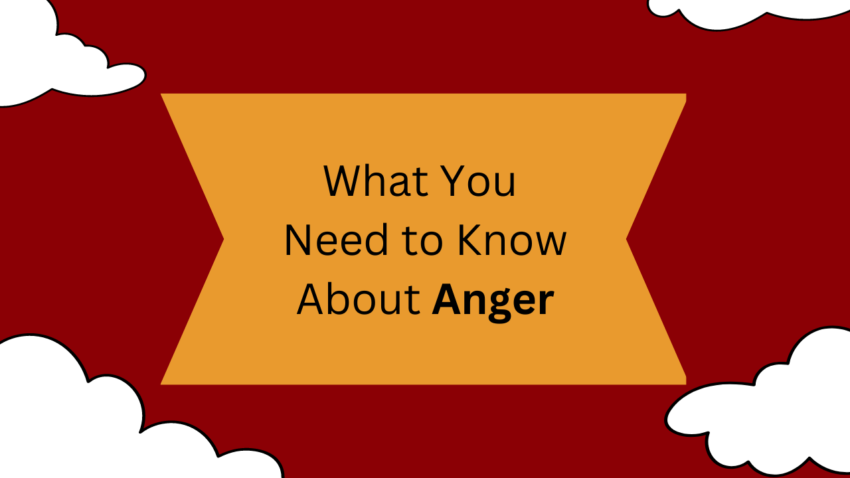Let’s Talk About Anger
Anger is a normal and necessary part of the human experience. There are specific things Anger does for us, what it communicates to others, and ways to change our emotions when we are angry, or should be angry.
What Are Anger Emotions?
As with all emotions, Anger is a category that houses a lot of other emotions inside. The different ways we experience anger depend on who is involved, what is happening, and what we believe about the situation.
Unfairness—Imbalance
- Displeased
- Bitter
- Outraged
- Petty
- Resentful
- Envy
Craving—Desire
- Greed
- Longing
- Covetous
- Demanding
Wrath
- Angry
- Agitated
- Annoyed
- Hostile
- Grumpy
- Pissed
Causes of Anger
Anger’s control center is in the brain, in a small almond-shaped section known as the amygdala. This control center is in charge of our “stress response” also known as “Fight or Flight” or “Fight, Flight, Freeze, or Fawn”. As a protective process, stress acts very quickly, with very little warning at times.
When we experience the stress response, our amygdala sends signals to our kidneys to produce adrenaline and cortisol, which act together to prepare us to handle threats. In the meantime, the amygdala asks other parts of the brain to chime in, and determine the correct action to take as a response.
Up to this point, we haven’t had a specific emotion yet, just the stress response. When we get information from the rest of the brain to contextualize the perceived threat, the emotion begins. If the threat is something to approach and address, we get Anger. When the threat is something to avoid or mitigate, we get Fear, which we will cover next week.
The interpretation of the need to act, combined with the stress response results in Anger.
What’s the Point of Anger?
Anger is a motivating emotion, which drives us to take immediate and decisive action. During the evolutionary process, this would have been required for any active threat, such as a predator attacking our child. Anger would give us an unrational amount of energy to protect the vulnerable person, along with a certain lack of self-preservation to enable us to challenge threats we would normally never dream of approaching.
In modern society, Anger continues to motivate us, and to communicate to others what we think is important. Without Anger, we would lack fundamental tools for communication, both in communicating internally and communicating with others.
Communication
Speaking of communication, let’s look at what Anger tells us and other people about us. Anger tells us that something needs fixing, and it needs fixing soon. When we get angry, our brain is also telling us that the subject of the Anger is very important to us.
When we get Angry in front of or around other people, our Anger communicates to them that the topic at hand is important to us. In many situations, Anger is the most effective way to communicate to other people that they are passionate about the issue at hands.
What Does Anger Feel/Look Like
Anger is characterized by the stress response, primarily. Our body prepares to leap into action. We may have a surge of energy, our skin becomes flushed and more full of color, and we may feel tense or ready to lunge into action.
As the stress response turns into Anger (which can be very fast), we produce more saliva, our heart rate increases, , and our sinuses clear. Adrenaline and Cortisol prepare every part of our body for action. Our digestion slows down, our Fear, Sadness, Anger, and Disgust are all suppressed to a degree, and we hyper-focus on the perceived threat. We may have trouble changing the focus of our attention, and feel the need to dwell on whatever has made us Angry, especially if we feel like we cannot fix the threat.
Seeing Anger in Others
The easiest ways to spot Anger are in people who are speaking especially loudly or quietly. They may also have clenched fists, which they may shake or gesture with. You might even see an Angry person drooling or spitting or breaking social norms that would normally be important to them.
Changing Anger
As a stress response, Anger leaves us prepared to feel Anger and Fear very easily. Thankfully, the stress response and Happiness, Sadness, and Disgust are housed in different parts of the body. This means that we can experience Happiness, Sadness, and Disgust at the same time as Anger, which can help you reduce your Anger.
Having a strong Happy response can enable us to completely ignore our stress chemicals while the Happy chemicals work on cleaning them up. This is why many anger management programs focus on the use of Happy visualizations and increasing Happy experiences.
When Anger Goes Wrong
Is Anger Useful?
When we become Angry, we tend to get what we want more often. This can be an extremely efficient way to get what we want. We get Angry, the other person interprets that we care a LOT about the issue, and then is more likely to give in because they don’t care as much as we do.
This is what leads to memes like the Angry Karen. People can universally understand the idea that someone uses their anger as a tool to influence others, and control the situation. Often, these people confuse the success they have in getting what they want with effectiveness. Unfortunately, using Anger as blunt weapon has short term rewards with long-term repercussions. When we are too Angry we lose credibility over time.
We have to be mindful of how often we are acting on our Anger, because doing so too often will convince others that our Anger is trivial, and capricious. They will dismiss the things we find important, and we will get what we want less often.
Is Anger Always Bad?
Anger is never a bad thing. What we do with that Anger may be more or less effective, but that’s neither good nor bad. For example, people who grow up in traumatic environments, like abused children, tend to have very little Anger, because it isn’t safe to express Anger at home. As they get older, they either begin to experience Anger that they lack skills to manage, or they fundamentally lack the ability to engage their Anger, making it harder for them to communicate effectively.
Anger Can Be (Re)Learned!
As a kid who grew up in an abusive home, I became very Angry as a young adult. In particular, my road rage was very disruptive. I would become inconsolably angry with others for minor infractions, and unreasonable when someone did something unsafe, such as cutting me off, or tailgating me while moving. Feedback from friends, therapists, and other drivers led me to understand that I had a “Problem.”
At first, I thought this was a personal failing, but that was the wrong way to think about it! I had to spend time considering where my Anger came from, and eventually realized I was actually afraid while driving, and I didn’t know how to manage that Fear. So, my body turned it to self-protective Anger.
To disarm my Anger, I practiced being Angry in healthy and safe environments. I also began thinking about the various incidents on the road that sparked my rage, and I practiced replacing those thoughts with kind, gentle, generous thoughts. By assuming and/or pretending the other driver had a good reason, or was on their way to help someone in need, I was able to disconnect my anger with them. Now, when I get cut off by another driver, I instinctively give them space, and wish them well, which is much more effective than spitting and yelling in my driver’s seat, if I do say so myself.
Want More Anger Topics?
Over the next two videos, we will cover Fear and Disgust. Once those are live, I will start sharing specific strategies and skills you can use to increase or decrease various emotions. I hope you will tune in for these videos, because these skills have changed my life for the better, and in my work I see them change the lives of others on a regular basis.
If you have questions, feel free to email me at Rory@UpRoryUs.com. I will collect questions and film one or more videos answering those questions.
Thanks for reading my post on Anger. Remember to be kind to yourself and others.

